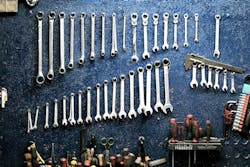Precision space engineering needs a partner that’s out of this world Keith Campbell, Castrol Industrial Lubricants
When it’s a mission to Mars there is no second chance. Anything that goes wrong could jeopardize a project that has been years in the making, costing several million dollars.
It’s an extreme environment. Temperatures in the summer are around 20°C (68°F) and at the polar extremes, -153° (-243°F). So, when you’re sending machinery into space, if it has a moving part, it needs lubrication that can cope.
Castrol’s Braycote lubricant was developed for NASA at the start of the space program in the 1960s and to this day it is used to keep the Mars Rover roving and the International Space Station in its 17,000 mph (27,400 km/h) orbit around our planet. As well as operating in extreme temperatures, Braycote has been formulated to prevent what is known as “outgassing”, which is the evaporation of grease, meaning that instruments can work at optimum levels, even at extremely high temperatures.
Braycote is used in the Mars Rover Opportunity, which originally launched as a 90-day mission and has now been working for more than 12 years. It’s broken the record for the longest distance travelled by a man-made vehicle on another planet or moon, and is still travelling around Mars. It is also used on the Mars Rover Curiosity, which was meant to be a two-year mission and has been up there for nearly four years. Castrol is continuing to work with the many space agencies and the burgeoning space tourism industry supplying its Braycote lubricant.
Braycote can also be used down on earth in manufacturing involving vacuums, with hostile chemicals and extreme environments, which is beneficial to the semi-conductor and microchip industry, as well as electronics, flat panel display and hard disk manufacturers. Other uses range from commercial aircraft to equipment used in the Arctic Circle.
Castrol’s top distributors, members of our Ambassador Club, get access to people and products that are out of this world. The Club meets every two years and its members get access to the freshest thinking on the planet that can inspire them in issues around their business. Recently Ambassador Club members were shown around a replica of the Mars Rover that Castrol exclusively agreed to borrow from NASA and show at the Chabot Space and Science Center in Northern California.
It’s an amazing industry to work in. Those in the industry know how pioneering the work is that we are doing, and for our distributors, there’s always something exciting to talk about with their customers. When I look up at the stars of the night sky, it’s stunning to think that – somewhere up there – are the fruits of my labours.
For more information visit www.castrol.com/distributors





